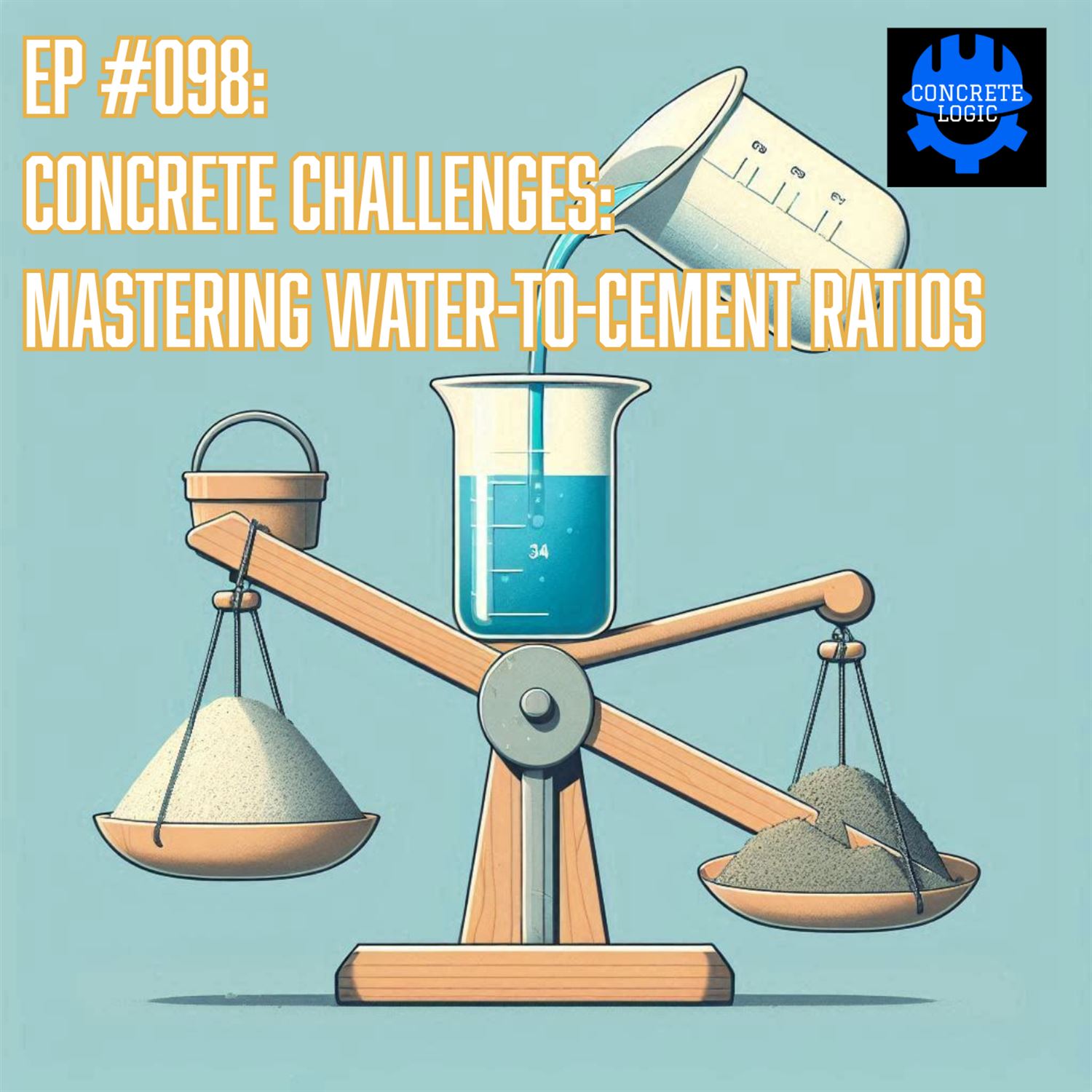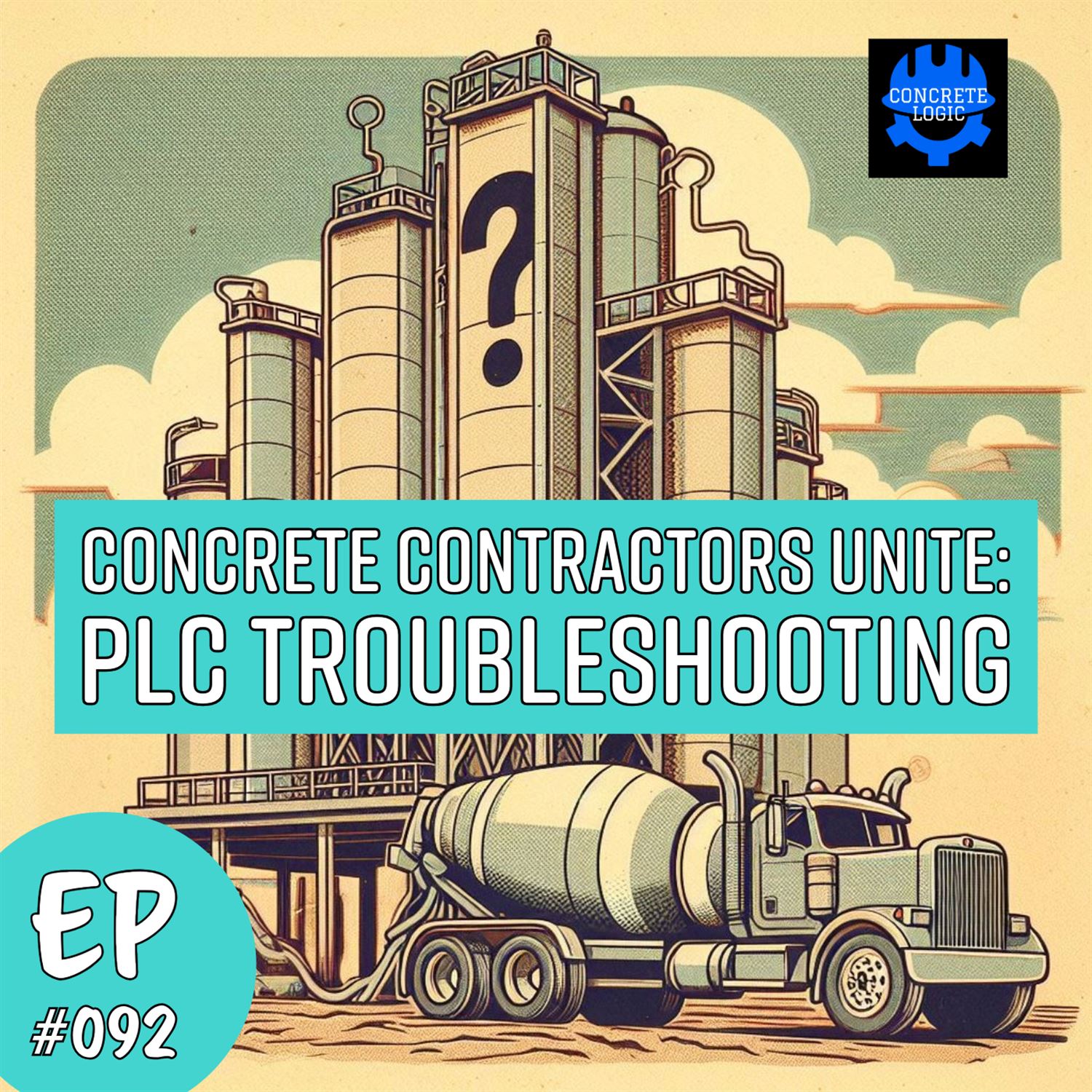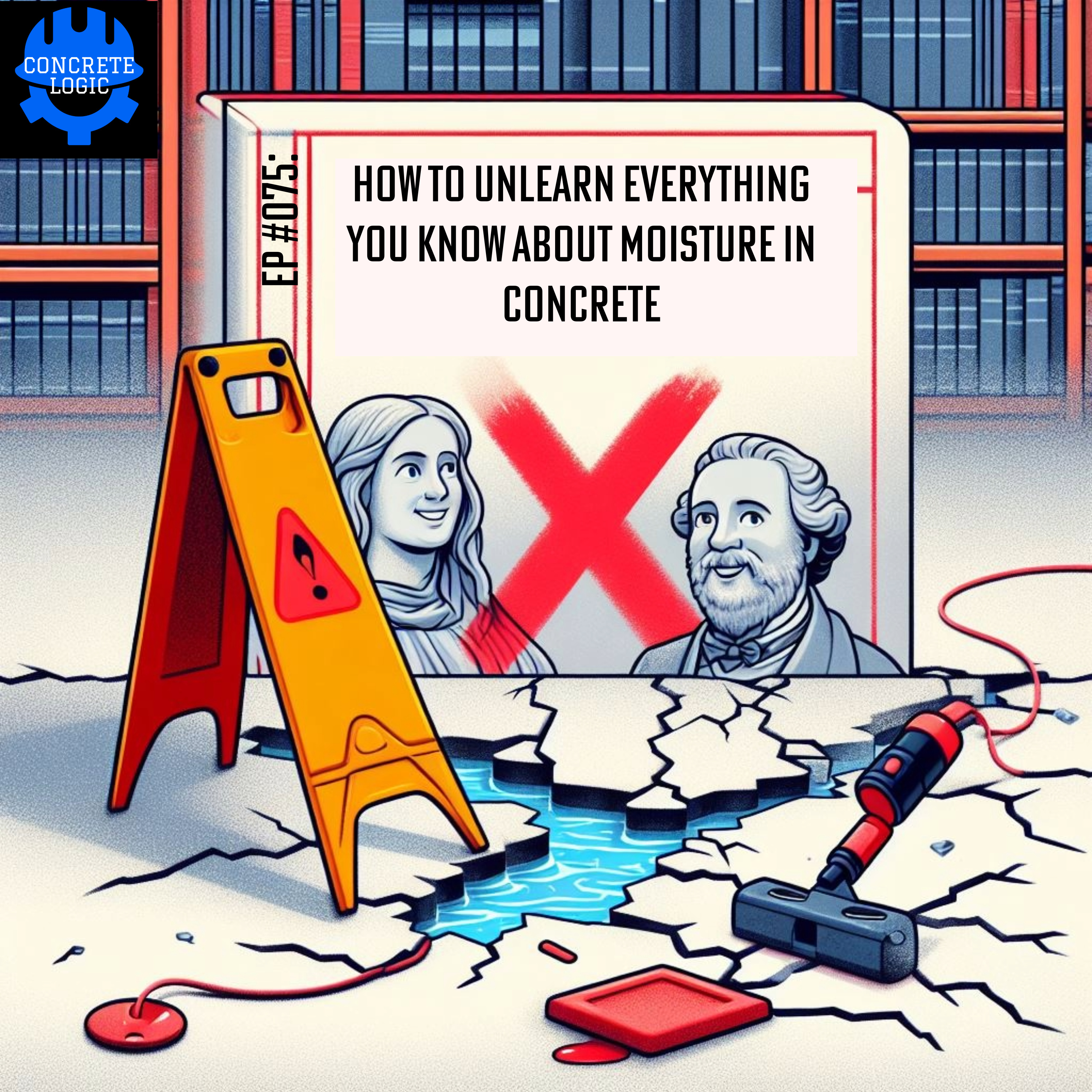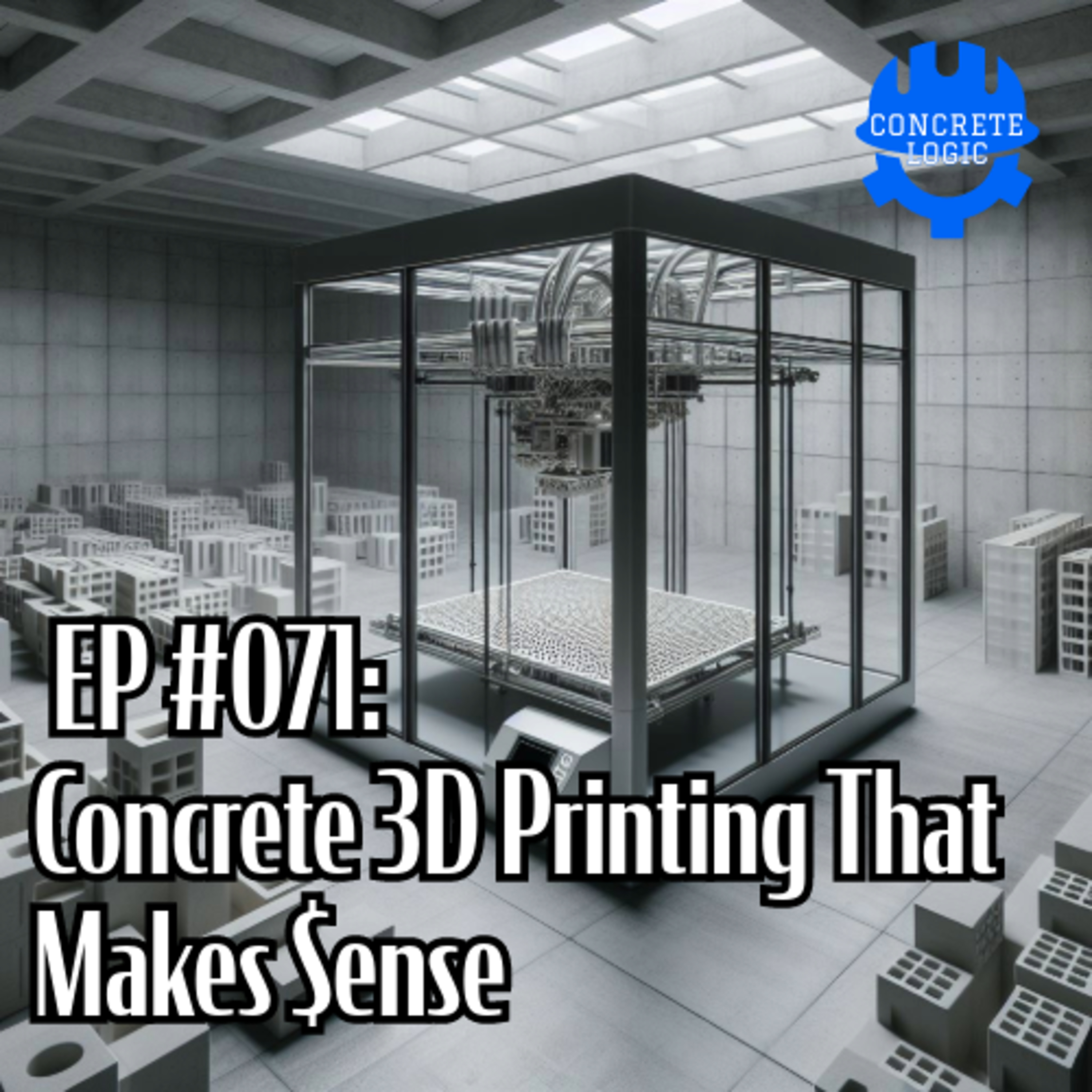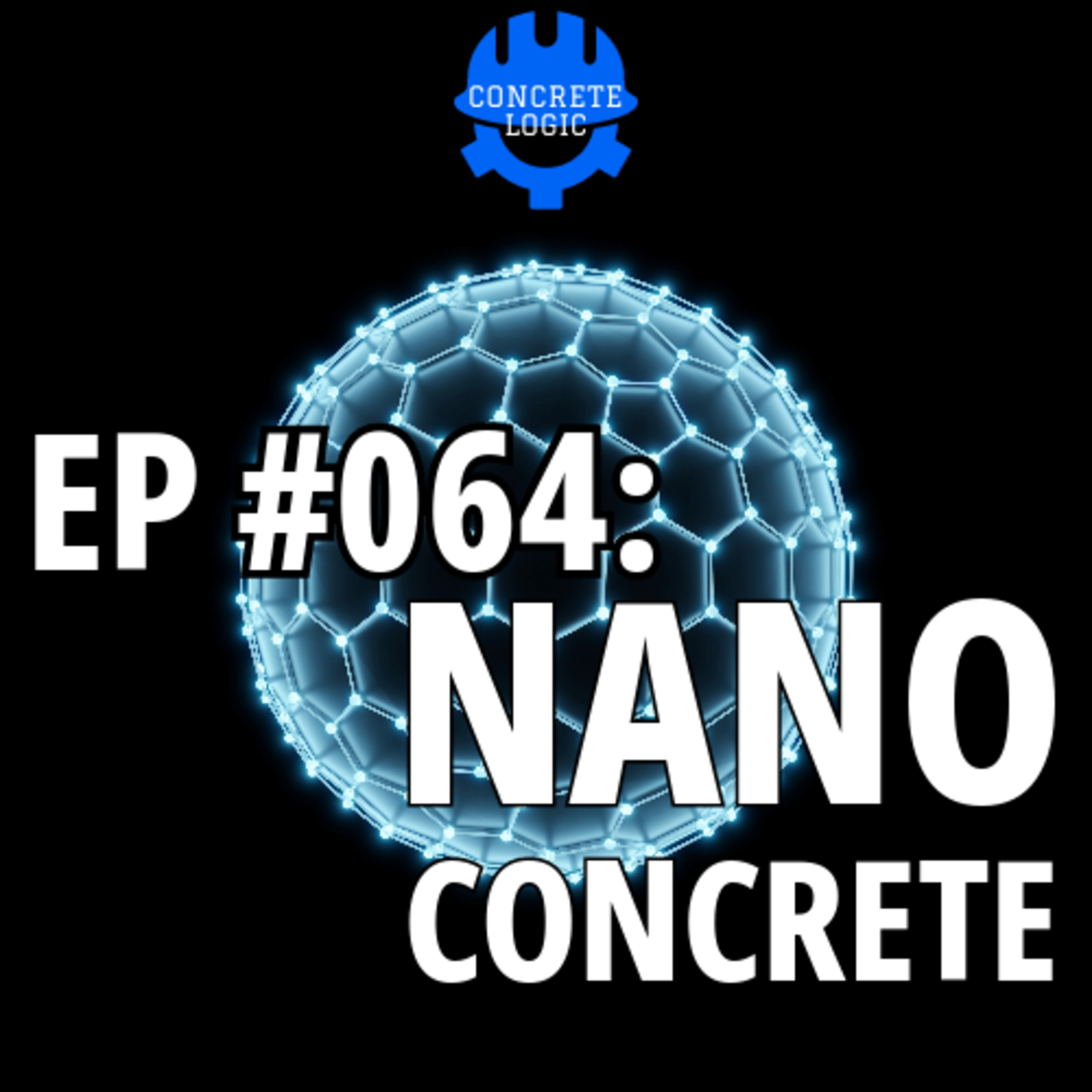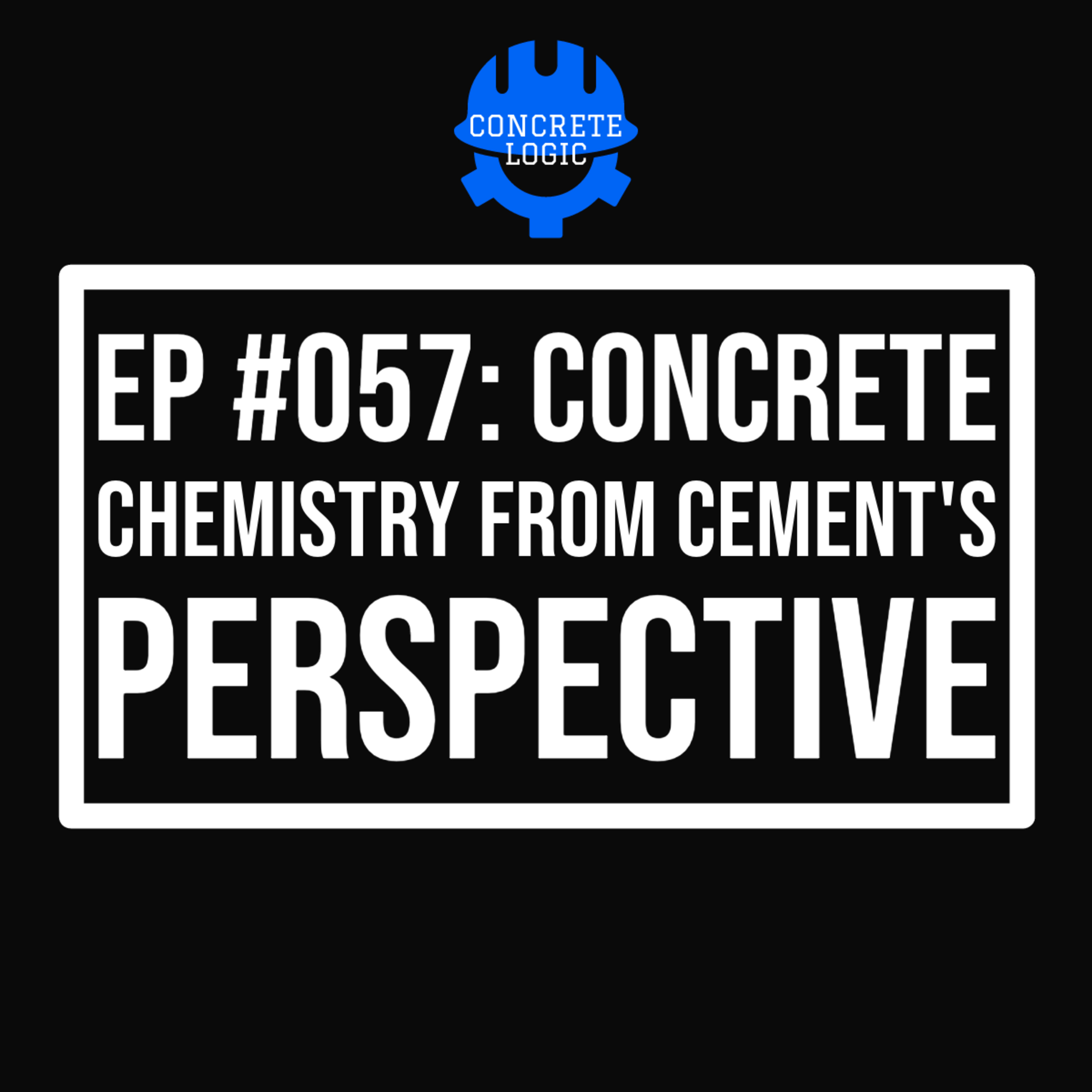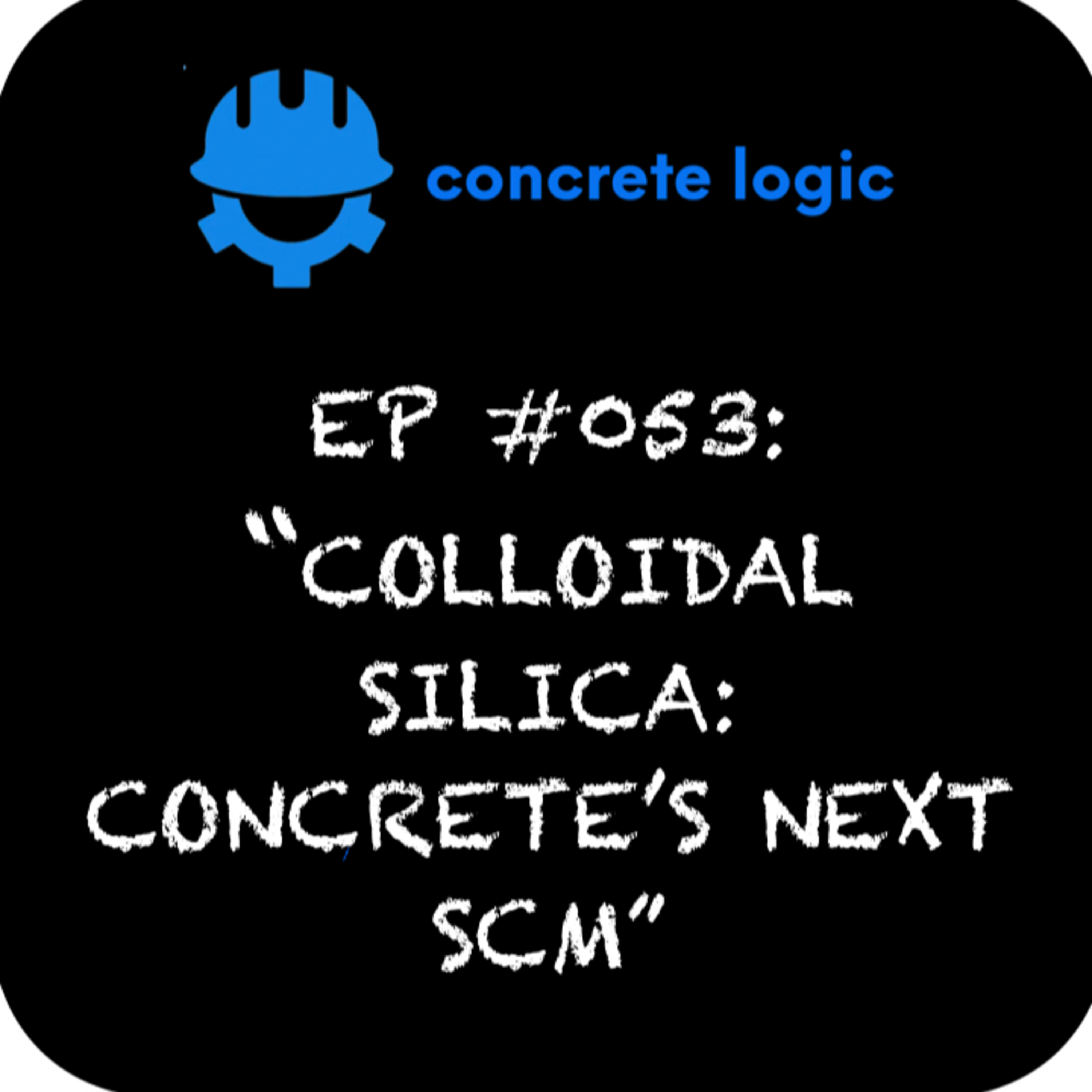
EP #009: Concrete Gets Hydrophobic


In this episode of the Concrete Logic podcast, we brought on Brent Rollins and Scott DiLoreto from Spray-Lock to discuss colloidal silica. If you are like most folks, you probably never heard of colloidal silica (CS). It is a product that can be sprayed on concrete during concrete placement or long after the concrete is cured. It can even be used as an additive to ready-mix concrete.
Once CS is applied to the concrete, it penetrates and fills up the microscopic (nano) voids it finds in the concrete and essentially makes the concrete waterproof! Although CS keeps water from penetrating the concrete, it still allows water in the concrete mix to escape just like it normally would in the curing process.
After this interview with Brent and Scott, your head will start spinning on how you can use colloidal silica in your future projects.
Did you learn something? Show your gratitude by donating to the show! Any amount, large or small, is greatly appreciated. Click on this link to learn more: https://www.concretelogicpodcast.com/support/
Episode References Guest: Brent Rollins, VP of Business Development, abrollins@spraylock.com Guest: Scott DiLoreto, Director of Sales, sdiloreto@spraylock.com Guest website: https://www.concreteprotection.com/
Donate & Become a Producer: https://www.concretelogicpodcast.com/support/
Music: Mike Dunton | https://www.mikeduntonmusic.com | mikeduntonmusic@gmail.com | Instagram @Mike_Dunton
Podcast host: Seth Tandett, seth@concretelogicpodcast.com Podcast website: concretelogicpodcast.com
Seth: [00:00:00] Alright, welcome to another episode of the Concrete Logic Podcast. Today I am with Brent Rollins and Scott DiLoreto. They're here today and if you guys could introduce yourselves one at a time and talk and your company.
Okay, and then we'll get into the subject of the day. So Brent, why don't you go ahead and start us off.
Brent: Sure. My name is Brent Rollins. I work for a company called Spray-Lock Concrete Protection. We're one of the leading providers of colloidal silica for the concrete construction market. I'm VP Business Development, which means that basically I get paid to make friends and develop relationships, and I love doing it. I love helping people, and that's why I'm in the industry that I'm in. Been in the concrete business [00:01:00] 30 plus years in some form or fashion. Don't, so I don't know it all. Nobody knows everything there is to know about concrete, but I've seen a number of things throughout my career that allow me to help others in a more efficient way.
So, Scott, you're up.
Scott: I'm Scott DiLoreto. I'm blessed to be a coworker of Brent's at Spray-Lock. I'm division sales rep in Texas and other various places across the country. I do stuff in... Virginia and Washington and Southern California all over the place.
Seth: Alright, so if you didn't catch what Brent mentioned before, today we're going to talk about colloidal silica and what that is.
I didn't know what the heck it was until I talked to these two guys about a week or so ago. And I guess the, If, Brent, if you could start us off, I think I [00:02:00] guess the best way to describe colloidal silica is it's a solution to maybe the helping the durability of concrete. Is that a right jumpstart spot?
Brent: Yeah, that's a great jump off spot. I'd like to tell a short story if I could, Seth. Just my own education with colloidal silica, how it came about. So it starts with, I had a 20 year career in the ready mix concrete industry. I started working at the age of 16 and spent many years in the concrete industry.
And you know, mostly as a tech guy dealing with the same old issues that we deal with. You know, low air content, higher air content, low slump, high slump, cracking all of those issues were things that I dealt with on a daily basis. Around 2010, I got tired of those issues taking up the majority of my day and wanted to look [00:03:00] into doing something more, wanted to help the industry more and had the wonderful opportunity to go to the University of Tennessee at Chattanooga to become their Director of the Civil Engineering Materials Research Lab there. So I got a chance to dip my toe into academic research with concrete. Basically, UTC gave me the wonderful opportunity to study anything I wanted to with concrete as long as I brought the funding in to support the work.
And concrete durability had always been an interest of mine because I felt like that our concrete structures weren't lasting as long as we wanted them to. And investigation you know, doing the research, figuring it out what was going on. I found out that no, you know our structures are not lasting a long time.
During that investigation, I ran across... colloidal silica [00:04:00] for the first time, probably in about 2012, 2011 2012, somewhere in there, and began to do some work. It came with a lot of claims, and I began to do some research to try to verify some of those claims, and quickly found out that colloidal silica really only does one thing, but it does it very well.
And that is it reacts and closes void space in concrete. So when it closes up void space, there's a lot of really good things that can happen to concrete when you take care of that void fraction. Number one, if you can shut down the movement of water, and the things that water carries into the concrete, then you can greatly extend the life cycle of concrete.
So by closing off that permeability you can really restrict the movement of things like chlorides, sulfates, nitrates, the other things that like to attack concrete. So from that, I [00:05:00] got to do a lot of work on colloidal silica and published a few papers along with some colleagues. Got to go around the world defending those papers, places like FIB, Rylam ACI, other places, and defend the work in front of my peers.
And then 2017 got an offer to go back into the private sector to try to make a difference in the real world. Because after all, guess what? Very few people read academic papers other than... Concrete nerds, you know, so I am a concrete nerd. I'm a self professed concrete nerd, but at the same time I needed a broader audience I wanted to make a difference in the real world So went back to work in the private sector and now I work it with Every day with helping people understand how colloidal silica is going to assist them in what they do.
the only thing I'd like to add is I've been in concrete ad mixtures for about 18 years. Or so when [00:06:00] Spray Lock came to me and they were like, Oh yeah, we're Spray Lock and we're interested in having you come to work for us.
Scott: And I was like, yeah, I think I've heard of this. You know, you guys do all this magic stuff and I'm not really too much of a believer in that. But after doing some research and talking to some people in the field and stuff like that, I found out one of the key things for me was that. Spray applied product can give you a as good or better than a 28 day wet cure for your concrete, and there's nothing better in the world for your concrete than curing your concrete.
It cures a lot of things that ale concrete. And when I realized that you could do that. And then be working on top of it within an hour, that kind of stuff. I said, I've got to go work with this product.
Brent: Yeah. And the way it's curing the concrete is so simply it's that activity of closing that void space.
So when you close that void space up, [00:07:00] you're also trapping water. You're not just keeping external water out of the concrete, but you're trapping the evaporable water is going to come out of the concrete between the time it sets in the first 28, 60, 90 days, you know, depending on thickness and environment.
If you can trap that water, hold it in to make it available for continued hydration, then you're talking about a product that absolutely cures concrete better than anything out there up to you know, as well as a 28 day moisture, which nobody does a 28 day moisture, very few people. You know, usually you're 7 to 10 days on a moisture and it's a headache.
So a one time application with the spray applied product. Can give you that level of performance just simply because it's holding that evaporable water in to allow that hydration process to continue. Great point, Scott. We, so colloidal silica, just what it is for those that [00:08:00] haven't run into it before.
It's an amorphous silicon dioxide particle, is all it is. It's just the same amorphous silicon dioxide particle that, that is contained in most of the pozzolans that you've dealt with or supplementary cementitious materials you've dealt with in the past, things like fly ash, slag, silica fume. The big difference being that the colloidal silica is a nano sized particle suspended in a carrier formula.
That nano size is the key to its performance because it allows two things to happen. One, it allows really deep penetration into the matrix, and what I'm talking about is the least we've seen typically on a four inch slab is an inch and a half penetration in the laboratory on a very dense mix. In the field, we typically see things, you know, half to a third the depth of the concrete member, or width of the concrete member in the case of walls.
overhead application. So it penetrates deeply, number one. [00:09:00] Number two, that very small size gives it a tremendous amount of surface area to react. That surface area is really the key to how effective of a pozzolan colloidal silica is because it's able to produce more reaction product because of that great surface area that it has.
So, those are the two key points on that small size and that's really what makes it different. But, it's also important to realize that there's a long history of pozzolan use in concrete. It goes back, you know, the Romans figured it out first and then we rediscovered it when Cal Berkeley scientists in the 1920s took coal ash for the first time and introduced coal ash in the concrete, what we now call fly ash in the concrete.
So, since then, we've been adding supplementary cementitious materials or pozzolans to concrete for a very long time. They have a great effect in helping improve [00:10:00] durability. But colloidal silica is the most active pozzolan discovered to date. So,
Seth: if we were to compare it to something else. So, I was thinking when we, when you all introduced.
This product colloidal silica to me and we were talking about their durability of concrete might my head went straight to like a sealer or you know, like a silane sealer or you know, something that you apply onto the concrete. But what we're saying is colloidal silica isn't actually a it's an admixture, right?
Scott: It's an admixture or a spray applied pozzolan.
Seth: Okay, so, so it could be, so it could be an admixture where it's part of your concrete mix, but at the same time it could also be well not at the same time, but in [00:11:00] another way to apply it is during place and finish, is that correct?
Scott: And to existing concrete as well.
Seth: Okay, so cured concrete, it can also be applied to? Yes. So it could act, so you mentioned Brent a bunch of different things that colloidal silica can do. You mentioned curing, so if it's used as a cure, obviously it would be applied during the place of finish.
Brent: Yeah, about the time you can walk on the concrete without leaving a boot impression. So you're allowing the finishing operations to conclude after the trowels get pulled off. And you're applying the product, typically you're applying the product ahead of the sawing. Because there's a window, there's a nice window there where usually there's not a lot going on besides waiting for the concrete to be ready to saw. And during that time, we found is a [00:12:00] great time to apply the product. It can go on later. It can go on after the sawing operation, but you have to be very careful to make sure that the slurry and stuff from your saws is cleaned up, because you don't want the stuff to react on the surface.
You want to allow it to penetrate into the concrete to do its thing. So really the key, even with existing concrete, When we say existing, we're talking about any concrete just about can benefit from colloidal silica application. The oldest concrete that I've personally been involved with was placed originally in 1921.
Where we were tasked with damp proofing or waterproofing the concrete in an aqueduct in upstate New York. And It took some mechanical prep to prepare the concrete to be able to accept the product and that, that's the biggest challenge in existing concrete. It's just making sure the product can get in.
But once it does, man it [00:13:00] reacts and closes up void space like you wouldn't believe. I've been involved in treating a tunnel that was first built in 1932. So the tunnel had some pretty bad problems with water movement through the matrix of the concrete so it was a combination of colloidal silica treatment and crack injection that waterproofed the tunnel for the city of Chattanooga actually a few years back.
So, so yeah, there's a couple of different delivery methods that I like, you know, I, simplify it as two as an additive at time of mixing or spray applied, but there's really, the spray applied can be broken down into time of placement is what I like to call it. which is at the time you typically put a curing compound down, or a little bit before.
Or what we call existing concrete, which can be concrete that's many years old will still benefit from colloidal silica application. [00:14:00] So it's a great product, and for me, I mean, there's a reason I left the university to go back in the private sector, and that was that I believe that this is one of the most important technical advances, if not the most technical advance, important technical advance I've seen in concrete ever.
I mean I had to be part of it, because I believe in the mission of making our concrete structures last longer. That is, in my opinion, the most important sustainability game we can play. When we're talking about environmental concrete practice, yeah, it's great to use recycled content. It's great to, to use regionally sourced materials.
All of those things that LEED wants us to do, those are all great, but... What if we can make our concrete structures last 80 to 120 years instead of 30 to 50 years, or 50, 60, if we can double the life? How important is that to the sustainability question? For me, that durability [00:15:00] is the key to having resources for future generations.
Let's make our structures last a long time, and we got it whipped, as we like to say in North Georgia and Chattanooga. Right.
Seth: So that way we don't have to tear things down and put them back up. Exactly. So, I just want to focus on the application At the time of place and finish first. Sure. So would a, as a concrete contractor, is there, would you see, notice any difference as far as the finishability of the concrete once it's put down?
Well, I'm not saying that, but you're saying you put it down as a cure, right? So we would finish and then put it down as a cure. Yes.
Brent: Yeah. So there are products that are out there that are provided in the marketplace that are colloidal silica products that are sold as finishing aids. So, those products do make several, you know, claims as far as their activity in [00:16:00] the troweling process and finishing process.
I'm not as familiar with that because that's just not something that, that we've ventured into, but other colloidal silica companies absolutely have products that tout themselves as finishing aids. And from what I understand, they're doing well. Okay.
Seth: But from your aspect, what you're an expert on is using it as a curing compound.
So, if we run across a specification that requires, which I have recently, that requires a wet cure and then we automatically send an RFI asking to do The chemical cure you've seen that successfully as far as switching a requirement from a wet cure to using colloidal silica?
Brent: Yes We do that often.
And the simple reason is that the reactions hold in that water, that evaporable water. And so you let the bleed water disappear, [00:17:00] of course. And then you apply the product, and it's holding the evaporable water in, which is going to leave typically between time of setting and that 28, 60, or 90 days, depending on thickness and environmental conditions.
But when you look at test results compared against moist cured samples. There's a very good case for using colloidal silica. So in, when you, when the reason that you're curing is compressive strength development and drying shrinkage reduction, those two things specifically are where colloidal silica shines.
Okay.
Seth: So it sounds like, okay, so you could use it as a cure and it lets, it keeps the water in the concrete and lets it emit like it usually does when it cures, but doesn't let water in. Right?
Brent: It's both ways. So it's holding water in, and it also doesn't let external water [00:18:00] get into the concrete and carry those contaminants into the concrete.
Yeah, so it's basically a two way barrier. The reaction product is common to concrete, and it becomes part of the concrete. So I didn't want to get too sciency here, but... You can't remove it. It's not a foreign substance that's in the concrete anymore. Once it goes in, it reacts and changes form. And when you look at colloidal silica treated concrete under a scanning electron microscope, you just see concrete that is, has had its microstructure refined to the point that the pore structure is very small.
So it's still allowing some water vapor movement. But what we have found is that it, the water vapor movement even is such that no adhesives or flooring or even paints care about vapor movement. It's so small. Typically, we're seeing below 0.1 [00:19:00] perms, so that's a really low level of water vapor movement.
Seth: Yeah. That was over my head. We need to bring it back to earth. Yes.
Scott: So. I'll put it this way. This Spray Lock is the company is an adhesive manufacturer for flooring, and so adhering things to concrete is what we do and how they got into this product. So that, it's just simple that way.
Seth: Right, and it, so, and then there's chemical cures out there that you have to remove before you apply flooring, right?
So you're saying if you use a colloidal silica product, you wouldn't have to remove it?
Brent: It penetrates, so it's not leaving anything on the surface. It's penetrating into the concrete. Leaving that mechanical key that's at the surface intact to be able to bond things to like adhesives or leveling courses or whatever.
It leaves that key intact and [00:20:00] then the performance is greatly enhanced because you're shutting down that moisture and water vapor movement.
Yeah, I was just going to say it's important to remember that also that colloidal silica is not new. Even though it has, it is new to many people because many people are just hearing about it for the first time.
The earliest concrete that I know of that was treated was like 1978, so it's been around 40 plus years, but now it's finally catching on, and there's, I know of about a half a billion square feet of concrete that has been treated with colloidal silica, so it's a mature technology in ASTM & ACI we are, I'm a member of several groups that are dealing with colloidal silica at the moment.
And that came up in the last ACI convention that we were at in Orlando, where in ACI 241 Nanomaterials in Concrete [00:21:00] is the title of that committee. And in that committee, it was stated, look, colloidal silica is a mature technology. Let's focus on guides and things that help people use it in the field.
The lab work's done. And so that's the focus now in those academic and standards bodies is trying to get more information out on how to actually use it in the field and what to watch out for and those kind of things. But it's certainly a mature technology that people can take advantage of now.
It's not it's not a future technology. This is something that's happening. And it's a very important advancement for concrete for sure.
Seth: Well, that's a common theme on this podcast normally talk about things that have been around for decades that folks know about or don't use because we're all, especially right now, we're all in a big hurry just to get things done, not taking a step back and see if there's a better way to [00:22:00] do some of these things that we do on every project.
So you're just a couple more things I wanted to talk about applying it. Okay. On existing concrete, so could you use it as like a water proof membrane on a retaining wall? Could you use it for something like that?
Brent: Yeah, so, so the thing to remember about colloidal silica is that it is a nanoparticle.
So, it's going to stop moisture and water movement through the matrix of the concrete. It's going to reduce crack chasing because you're sealing sidewalls of cracks. That kind of stuff, but the likelihood is that you're still going to have to inject some cracks because again, it's a nano material It's not going to bridge cracks real well.
So it's part of a system when it comes to waterproofing a retaining wall Okay part of a system that involves some crack filling and those kind of things but so, [00:23:00] so we're careful when we say you can waterproof a wall with it. Well, yeah, you can, but you also will probably have to do some injection to take care of your macro voids, if you will.
Seth: Okay. how about on a parking garage where they normally require a silane sealer? Could it replace the silane sealer?
Brent: Absolutely, yes. Scott, you've got some experience talking with folks about that too, I'm sure.
Scott: Yeah, no, it works really good in parking decks replacing parking deck coatings and stuff like that.
And or with certain products, if they want the additional waterproofing type stuff. You can get it on in as little as 14 days after fresh placement of concrete. So it really actually helps speed up the construction cycle.
Brent: Yes, that's a very important point is that you can apply anything to colloidal silica treated [00:24:00] concrete that's going to stick to concrete as early as 14 days after application of the product.
And that means that you can hard schedule those installations. Many times there's conversations about, hey, the moisture reading in hallway B is at six pounds per thousand square foot for 24 hours and we can't put our flooring in. Those conversations can be a thing of the past with the use of colloidal silica because it can allow your flooring guy or your coding guy can mark it down on the calendar.
I will be there that day applying. And with no testing as well. Yeah, with no testing needed because we know that's covered.
Seth: All right. I'm a bit of a parking garage nerd, so I'm thinking back to parking garages. What so if you put it down as a cure though, It's going to do its job, and you don't need to apply it like a sealer, because normally when you build a parking garage, you're doing [00:25:00] the gymnastics of figuring out when you're going to put the silane sealer down, and then when you're going to put paint stripes down, and then the cleaning involved in both things, both putting silane sealer down and the paint.
So in My, I guess my logic, I'm thinking you put it down as a cure during place and finish and then you're done, right? You don't need to put sealer down and then the paint, it's up to the paint guy to get his, paint down. And there's no concern about the paint adhering to concrete once this applied to, right?
Brent: Yeah. Anything that'll stick to concrete normally will stick to colloidal silicone treated concrete. There's no issues there at all. You know, you can't leave, you gotta make sure that you don't leave the product on the surface to dry out and then try to, you know, adhere something to it.
So, it is a penetrant, but it does and it is applied to a [00:26:00] application rate in square feet per gallon. But sometimes the concrete is dense enough not to take it all. And if it doesn't take it all, you don't wanna let that dry out. You want to move it off the slab, and then you'll have a great surface to bond to.
Scott: Another thing about colloidal silica applications, and this goes, our product as well as most of the other ones that I know about, it's a spray, spray on, and you let it absorb, and then if there's any excess, you move it off. There's no scrubbing it in and you know, extra labor involved in it.
It's fairly low labor and easy to do.
Brent: Yeah, and Scott, you brought up something that's important that a lot of folks will make a leap, because they've heard about the silicates that are [00:27:00] in the market, and colloidal silica sounds a lot like silicate. So a lot of people assume that silicate, that the colloidal silica is a silicate, or it behaves like the sodium, potassium, lithium silicates that have been around since the 50s.
In the end, it's not. It's totally different. It's a different action. It's a different product because it's an amorphous silicon dioxide particle that's on the nanoscale. It penetrates concrete like nothing else on the market. Whereas those silicates that we have in the market they do a good job in their own respective areas, but they often require that scrubbing and extra steps that you're talking about stuff.
Seth: So I think it's important to draw that distinction because we do get confused with silicates from time to time. If we can circle back to using it, using colloidal silica as an additive to the concrete mix.[00:28:00] And you mentioned before about the sustainability of it. So if we could talk about it as an admixture or additive to the Ready-mix what are some benefits there?
I've seen some, but I want you guys to, I guess, tell me.
Brent: The number one benefit for me being an ex Concrete guy, ex Ready-mix QC guy is that you can, for durability purposes, if you're using a silica fume, for instance for added durability you can replace that silica fume with a certain dose of colloidal silica.
And instead of handling a bag powder product that is a pain, honestly to put into the trucks, you're now dealing with a liquid that is dispensed like an admixture. You might draw a distinction. It is a mineral additive, but it's dispensed like an admixture, and that just [00:29:00] speaks to the safety, the ease of use.
I mean, that's a big deal for a lot of concrete companies, because they don't want to have an extra guy on the wash rack, you know, ripping bags and putting stuff in. If you can run it through the admixture pump, then it's a much, much easier way to get that added durability. So that's one positive thing.
on the finish side, I think you'll find that if you use the integral you get a lot easier finishing. It's available to be used in shotcrete as well, can help reduce rebound and help with compaction.
imagine if you're putting on billions and billions of little ball bearings in your concrete nano sized ball bearings in your concrete. So we see typically things like pump pressure go way down, workability is improved, [00:30:00] performance is improved because it helps close up the void structure.
So you're getting, not only are you getting a durability improvement by reducing permeability, but you're also getting that fresh concrete workability improvement that a lot of people really love, but it's hard to, it's hard to put numbers on, you know, it's difficult for me to explain to someone, yeah, you're going to see more workability, well, what does that mean?
Does that mean more slump? No, not typically, but it just means less resistance to movement, so your right guys, you're come- along guys. Thank you. are going to notice that, hey, this is easier to move. This is it flows and holds together better. It holds self consolidating concrete mix, for instance.
It's going to hold that SCC mix together. Like nothing else. I mean it's a beautiful product.
Seth: And as far as I, I saw, [00:31:00] is there any truth to it increases compressive strength?
Brent: Yes. So you have, one important thing to remember is that colloidal silica is different from different manufacturers. The only thing it has to do to meet the definition that's currently being considered is, Has to be less than a hundred nanometer sized particle.
Well, when you start talking nanometer sized particles, you're talking about the smallest of the smaller. You're talking about a performance can vary greatly between a 30 nanometer product and a 60 nanometer product. So some products specialize in giving you a strength boost. Some products are going to special, you know their particular wheelhouse will be an, a permeability improvement.
Some of them will be a workability improvement, and it all boils down to particle size and carrier formula, those kind [00:32:00] of things, but particle size is really one of the big ones in the performance of the colloidal silica. So it depends on what you're looking for.
Here's a good example. Let's say you've got a particular mix that has a durability requirement. You've got to get below a certain number of coulombs in the rapid chloride permeability test. And say it's a parking deck on the ocean or something and it's, you know, the engineer's really wanting to get a nice durable mix.
Your normal concrete mix, even though 4,000 PSI compressive strength is all that is required to hit those permeability numbers. You might have to have an 8,000 PSI mix to get those numbers. You might have to have 15 to 20 percent or sorry 15, you might have to have 10 pounds, for instance, silica fume.
You might have to have a certain percentage of pozzolans and you might have to have a lot of powder content. The thing that colloidal [00:33:00] silica can do is it can help you hit those durability numbers with a normal strength mix. So all of a sudden, instead of 8,000 PSI mix, if you can hit those Coulomb numbers, With a 4,000 and it still have the strength you need, imagine the economics, how that works out, and imagine how much easier it is for the concrete finisher who's out there trying to place this 8,000 PSI, 0.35 water-cement ratio kind of mix. And that's an ugly mix, and it's hard to place.
Scott: With three gallons of CNI in it. As an accelerator.
Brent: So, colloidal silica can help reach those permeability numbers, those durability numbers without adding all that additional powder, which also does what?
Shrink, right? But drying shrinkage, the more powder you got in the concrete, the more it's gonna shrink. So, it can help on so many levels by providing that durability without adding that additional power.
Seth: That's what I saw, but I wanted to see if that [00:34:00] was true or not. And then Scott, do you want to explain to everyone?
Because not everybody knows what CNI is.
Scott: Yeah, calcium nitrate. Sorry, old admixture guy. It is used as a corrosion inhibitor. Typically from one to six gallons, but it's as effective as non chloride. So think non chloride accelerator. So think of putting a gallon or three gallons of non-chloride accelerator in your super high powder mix with low water.
And try to get an air test and a slump test and make some cylinders before that stuff goes off. It can be, it's a hassle for the plant to batch it consistently, load to load. It makes it tough on the testing and it makes it super hard on the place and finish guys.
Seth: Oh yeah, place and finish guys hate that stuff.
[00:35:00] So are you saying that the colloidal silica could be a replacement for that CNI as well? You've seen that case use?
Brent: Yeah. you see similar or better numbers when you do the life cycle analysis. If you refine your permeability, you get that permeability down low enough, then you're going to have a life cycle that's going to be better than even three gallons a yard or more CNI.
Or in some cases even, you know, you run it through with the coated rebar or stainless rebar You can make a case for using it instead of some of those more expensive durability type applications. So, of course, those are all engineering decisions, and those are all decisions you work with that design team, you know, to see if there's a better way.
If there's a more sustainable way or a cheaper way or a, you know, just depends on what you're looking for and what's important for the project. But the answer is yes, in many cases, [00:36:00] colloidal silica can be an answer to those durability. Challenges, if you will.
Seth: It's not an answer to all, but it's definitely something we need to explore when we're running across those things, because I've been on jobs where, you know, you got those mixes where they got the shrinkage admixture, the CNI, all this other chemical stuff, and you're dealing with more chemicals than you are almost concrete, it seems like.
Chemcrete. if you could limit, the number of ad mixtures you're going in, if there's like colloidal silica, if you can use that instead of one or two of those things definitely think it's a solution, but it's like anything else, you know, it's not the end all silver bullet of things and I'm sure there's a point where you can only put so much of it in the concrete and then it becomes detrimental to the mix as well.
Is that true as well?
Brent: Yeah, you [00:37:00] want, you have a sweet spot in any mix and depending on the product and that sweet spot is going to be where you get the biggest benefit for strength and durability performance. And your manufacturer, whoever the colloidal silica manufacturer is going to be able to provide information on that particular sweet spot.
But yeah it's definitely, there is a point of limited return when you know, if you put two gallons in and it works great, then it doesn't necessarily mean that four gallons is going to be twice as good. It's like an aggregate variation in a lot of ways.
So if you've got too much of one size rock in a concrete mix, then that's going to be an ugly mix. Well, if you've got too much of the tiny nanoparticles in a mix, then you might run into a mix that all of a sudden two gallons makes it workable, but four gallons makes it sticky. Or like you might see with some of the silica fume type mixes, where you've got such a fine [00:38:00] powder.
You know, you can go overboard with that stuff, and all of a sudden, you can't finish it anymore. You can't, it doesn't want to move around or it kills slump, you know, you got two inch slump loss in between the time the concrete truck gets there and the time it's placed. So, yes, there is a point that is too much colloidal silica.
We want to be sure that it's in that sweet spot where the fresh and hardened performance is what you're looking for.
Seth: That's with anything else you put in concrete. So there's a point where it's beneficial and then there's a cliff that you get to. It's no longer beneficial.
But I think that's a great spot to end the discussion today. Brent and Scott, if folks want to reach out to you and learn more about colloidal silica and Spray-Lock , Brent how should they get ahold of you?
Brent: Thank you. Yeah, so email or cell phone number, either one. I'll answer my cell phone as [00:39:00] long as I'm not sleeping.
So yeah, so that's abrollins@spraylock.com. Cell phone number is 423-593-6674. Get a hold of me anytime or hit me up on LinkedIn. LinkedIn is a great way to introduce yourself.
Scott: Same here. LinkedIn is a great way to get to me. My email is sdiloreto@Spraylock. Com and my cell phone number is 253-365-4437. And if you want to go to our website, it's ConcreteProtection. com.
Seth: Yep, so hopefully some folks will check it out next time they run across a challenge like we discussed today. Sorry, we didn't get to talk about Atlanta Braves or college football. Maybe next time.
Brent: Go Dawgs!
Scott: Thanks for the opportunity, Seth.
Seth: Yeah, thank you for coming on, and we'll have to do it again.











